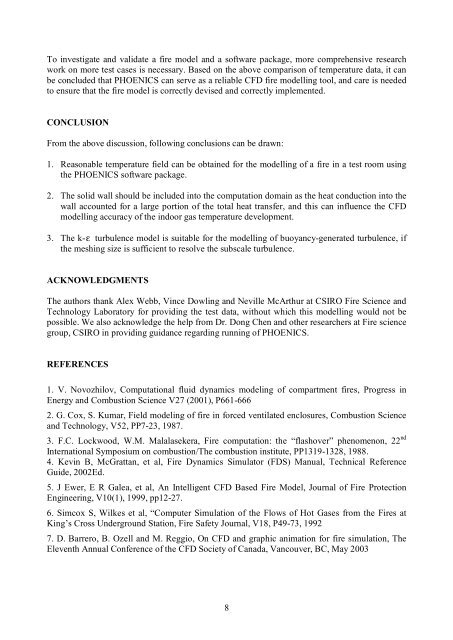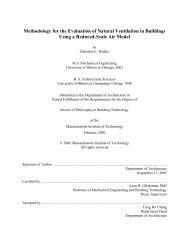EVALUATION OF PHOENICS CFD FIRE MODEL AGAINST ... - Cham
EVALUATION OF PHOENICS CFD FIRE MODEL AGAINST ... - Cham
EVALUATION OF PHOENICS CFD FIRE MODEL AGAINST ... - Cham
You also want an ePaper? Increase the reach of your titles
YUMPU automatically turns print PDFs into web optimized ePapers that Google loves.
To investigate and validate a fire model and a software package, more comprehensive researchwork on more test cases is necessary. Based on the above comparison of temperature data, it canbe concluded that <strong>PHOENICS</strong> can serve as a reliable <strong>CFD</strong> fire modelling tool, and care is neededto ensure that the fire model is correctly devised and correctly implemented.CONCLUSIONFrom the above discussion, following conclusions can be drawn:1. Reasonable temperature field can be obtained for the modelling of a fire in a test room usingthe <strong>PHOENICS</strong> software package.2. The solid wall should be included into the computation domain as the heat conduction into thewall accounted for a large portion of the total heat transfer, and this can influence the <strong>CFD</strong>modelling accuracy of the indoor gas temperature development.3. The k-ε turbulence model is suitable for the modelling of buoyancy-generated turbulence, ifthe meshing size is sufficient to resolve the subscale turbulence.ACKNOWLEDGMENTSThe authors thank Alex Webb, Vince Dowling and Neville McArthur at CSIRO Fire Science andTechnology Laboratory for providing the test data, without which this modelling would not bepossible. We also acknowledge the help from Dr. Dong Chen and other researchers at Fire sciencegroup, CSIRO in providing guidance regarding running of <strong>PHOENICS</strong>.REFERENCES1. V. Novozhilov, Computational fluid dynamics modeling of compartment fires, Progress inEnergy and Combustion Science V27 (2001), P661-6662. G. Cox, S. Kumar, Field modeling of fire in forced ventilated enclosures, Combustion Scienceand Technology, V52, PP7-23, 1987.3. F.C. Lockwood, W.M. Malalasekera, Fire computation: the “flashover” phenomenon, 22 ndInternational Symposium on combustion/The combustion institute, PP1319-1328, 1988.4. Kevin B, McGrattan, et al, Fire Dynamics Simulator (FDS) Manual, Technical ReferenceGuide, 2002Ed.5. J Ewer, E R Galea, et al, An Intelligent <strong>CFD</strong> Based Fire Model, Journal of Fire ProtectionEngineering, V10(1), 1999, pp12-27.6. Simcox S, Wilkes et al, “Computer Simulation of the Flows of Hot Gases from the Fires atKing’s Cross Underground Station, Fire Safety Journal, V18, P49-73, 19927. D. Barrero, B. Ozell and M. Reggio, On <strong>CFD</strong> and graphic animation for fire simulation, TheEleventh Annual Conference of the <strong>CFD</strong> Society of Canada, Vancouver, BC, May 20038
















